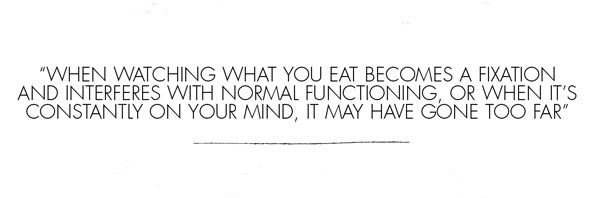Calorie counting and carb restriction are second nature to many women. Sarah Garden should know, she’s one of them…
I don’t have an eating disorder, I’m a healthy weight and I probably consume more than my fair share of curries. Yet in my quest to maintain a single-figure dress size I have: boiled a stock cube in water and called it soup, ‘forgotten’ to eat meals, begun every single morning of my working week by consuming four dry water crackers, thrown unopened and imperishable food in the bin to stop myself eating it and checked the calorific value of lettuce.
Reading that back makes me cringe. It smacks of the shallow, celebrified society that makes intelligent women across the world feel objectified. However, many of the women who chastise tabloids for printing stories about the fluctuating size of Kim Kardashian’s derriere also count their lunchtime calorie intake – myself included.
Mocking the female obsession with weight loss is nothing new – Bridget Jones’ weighing scale habits chimed with a generation of yo-yo dieters, and who could forget the famous quote by Cher in Clueless: “I feel like such a heifer. I had two bowls of Special K, three pieces of turkey bacon, a handful of popcorn, five peanut butter M&M’s and like three pieces of licorice.” Bingo wings and muffin tops are a longstanding fixation. However, newer ideologies such as the ‘the gap’ (the space thin women have between their thighs) demonstrate that our body image pursuits show no sign of slowing. This obsessive behaviour, which isn’t as life consuming as an eating disorder, is being coined as ‘semirexia’.
According to Dr Bijal Chheda Varma, head of the eating disorder unit at Capio Nightingale Hospital in London, UK, semirexia is common. “Many women probably identify with mild food obsession,” she says. “This is because society and media are very food focused in both good and bad ways. Food obsession provides women with a sense of control and power over their bodies, which they may not feel in other areas of their lives. Hence it provides a short term feel good factor.”
Seeing as the majority of us fall into this category, it must be doing something to make us feel good. The University of North Carolina found that three out of four American women between the ages of 25 and 45 have semirexia. That counts as anything less than a diagnosed condition, from regular dieting to carb cutting.
With an obesity endemic affecting many corners of the globe, it’s difficult to decipher the mixed messages. On one hand, we should all watch what we eat, but on the other, we can’t let this spiral into extreme restriction. Dr Bijal says that dieting only becomes an issue when it takes over your life. “It’s normal for people to think about their diets and food on a daily basis. However, when it overwhelms people’s thoughts and appears to interrupt healthy functioning, then it may be a problem,” she explains. “Mild obsessive behaviour around food does not automatically put someone in danger of developing an eating disorder.”
However, Dr Bijal emphasises that semirexics are treading on dangerous territory. She sites an extreme fear of becoming fat, rather than fear of eating the wrong foods, as one of the many typical risk factors. “This, along with pre-occupation of body image, would highlight a risk of an eating disorder,” she explains. “When watching what you eat becomes a fixation and interferes with normal functioning, or when it’s constantly on your mind, it may have gone too far.”
The upshot is, turning down a chocolate bar because you had a chicken korma the night before is perfectly normal, as is trying to maintain a relatively clean diet. But if you find yourself thinking, “I can’t possibly have that casserole, I ate four roast potatoes last week”, it may be time to cut yourself some slack.
Underfeeding your body has multiple side-effects aside from weight loss. “The harmful impact on healthy bodies includes [low] bone density, loss of menstrual cycle, agitation, poor focus and attention, and loss of pleasure,” says Dr Bijal. “Undereating provides a short-term feel good factor, which individuals interpret as a faulty message to engage in more restriction. Once the cycle of restriction and short-term high from undereating begins, it’s a viscous trap to get out of.”
Though it’s easy to see how semirexia can become a problem, the causes aren’t easy to identify, because it’s a phenomenon that’s ingrained into generations of women. “Negative attitudes are learned from various sources and are accumulated at various stages of development,” explains Dr Bijal. “Our early attitudes towards food often come from the family. However, other influences such as our peer group, changing diet fads in the media, and conflicting messages from the slimming industry, also lead to negative and unhealthy attitudes.” Aimee, a 27-year-old nurse, recognises herself mirroring many of her mother’s dietary habits. “My mum would often dish up large helpings for the family, and then put her own portion on a side-plate,” says Aimee. “She’s always been terrified of ‘bad’ foods that are high in sugar. As a result, I can’t enjoy desserts or chocolate, they make me stressed.”
Many of us feel this stress over highly calorific foods, not because we’re worried about the negative impact they’ll have on our health, but because of the negative impact they’ll have on our body. Nutritionist Susan Fraser says too many women view food the wrong way. “Starving yourself or eating fat-free options that are filled with preservatives is just as unhealthy as eating fatty foods. Seek out natural foods that nourish your body,” she advises.
I know that my quest to stay slim isn’t about keeping fit – there’s nothing healthy about eating water crackers instead of breakfast, or consuming large amounts of diet drinks. Susan warns: “It’s not about the fat you can see, it’s about the fat you can’t see – the stuff that surrounds your organs and clogs your arteries. We should focus on keeping our bodies healthy and, as a side effect, we’ll stay slim.”
Image: Getty














